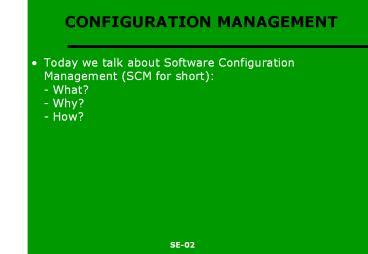CONFIGURATION MANAGEMENT - PowerPoint PPT Presentation
1 / 13
Title: CONFIGURATION MANAGEMENT
1
CONFIGURATION MANAGEMENT
- Today we talk about Software Configuration
Management (SCM for short)- What?- Why?- How?
2
WHY CM?
- Multiple people are working on changing software
- More than one version of the software needs to be
supported - Different releases
- Different installations with different
functionalities - Development versions
- Software needs to run on different operating
systems and different hardware
3
WHAT IS SCM?
- Configuration management is a way to manage
evolving software - Configuration management is a set of disciplines
and techniques for initiating, evaluating, and
controlling change to software products. - Configuration management covers the lifecycle of
software development
4
SCM Activities
- CM data management
- Version management- Release versions-
Development versions - Concurrent development management
- Change management
5
SCM Items
- Design documents
- Code files
- Test data
- Test drivers
- Manuals
- System configuration data
- Etc.
- A meaningful combination of above, meant to be
treated as a single entity - Also hardware items can be considered CM Items
6
Managing SCM Items
- There may easily be thousands of SCM items
- A naming scheme should be introduced to identify
these - The hierarchical arrangement of software project
items should be supported - Should all CM items be managed
- When to start management for an item?
- If you start too early, you get bureaucracy.
- If you start too late, you get chaos.
7
Baselines
- Baseline A specification or a product, which is
formally reviewed and agreed on, and which can
only be changed through formal change procedures - Before an item becomes a baseline, changes can be
made quickly and informally. - Baseline is a kind of a milestone in software
development - Baseline typically creates new versions in SCIs.
8
Version control
- Procedures and tools to manage different versions
of configuration objects - Versions may not always be created in sequential
order, e.g. you create 1.0 -gt 1.1 -gt 1.2 -gt 2.0
and then you need to create 1.3 for some
customers who can not run 2.0 but need some
changes or improvements. - With big software, you may e.g have 4.0 as the
official current version. You work on 5.0 to
release it as the next official version, but you
have already started to create 6.0, as it takes
so long to get it ready.
9
Change Control / 1
- Need for change is recognised
- Someone (like a user) makes a change request
- Developer evaluates
- Change report is generated
- Change control authority decides
- Change is denied -gt User is informed
- Change is accepted -gt go to next slide )
10
Change Control / 2
- 6. Change request is queued for action and and
engineering change order (technical descr) is
made - 7. Assign individuals to make changes to
configuration objects - 8. Check out configuration items from project
repository - 9. Make the change
- 10. Review (audit) the change
- 11. Check in the changed configuration items
- 12. Establish a baseline for testing the change
- go to next slide )
11
Change Control / 3
- 13. Perform quality assurance (QA) and testing
activities - 14. Promote changes for inclusionin next
release - 15. Rebuild appropriate version of software
- 16. Review (audit) the change to all
configuration items - 17. Include changes in new version
- 18. Distribute the new version
12
SCM Audit / 1
- The following questions should be answered
- Has the change specified in the ECO been made?
Have any additional modifications been
incorporated? - Has formal technical review been conducted to
assess technical correctness? - Has the software process been followed and SE
standards been applied? - Has the change been appropriately recorded in the
SCIs?
13
SCM Audit / 2
- More questions to be answered
- 5. Have Software Configuration Management
procedures for the change been followed? - 6. Have all related SCIs been properly updated?































